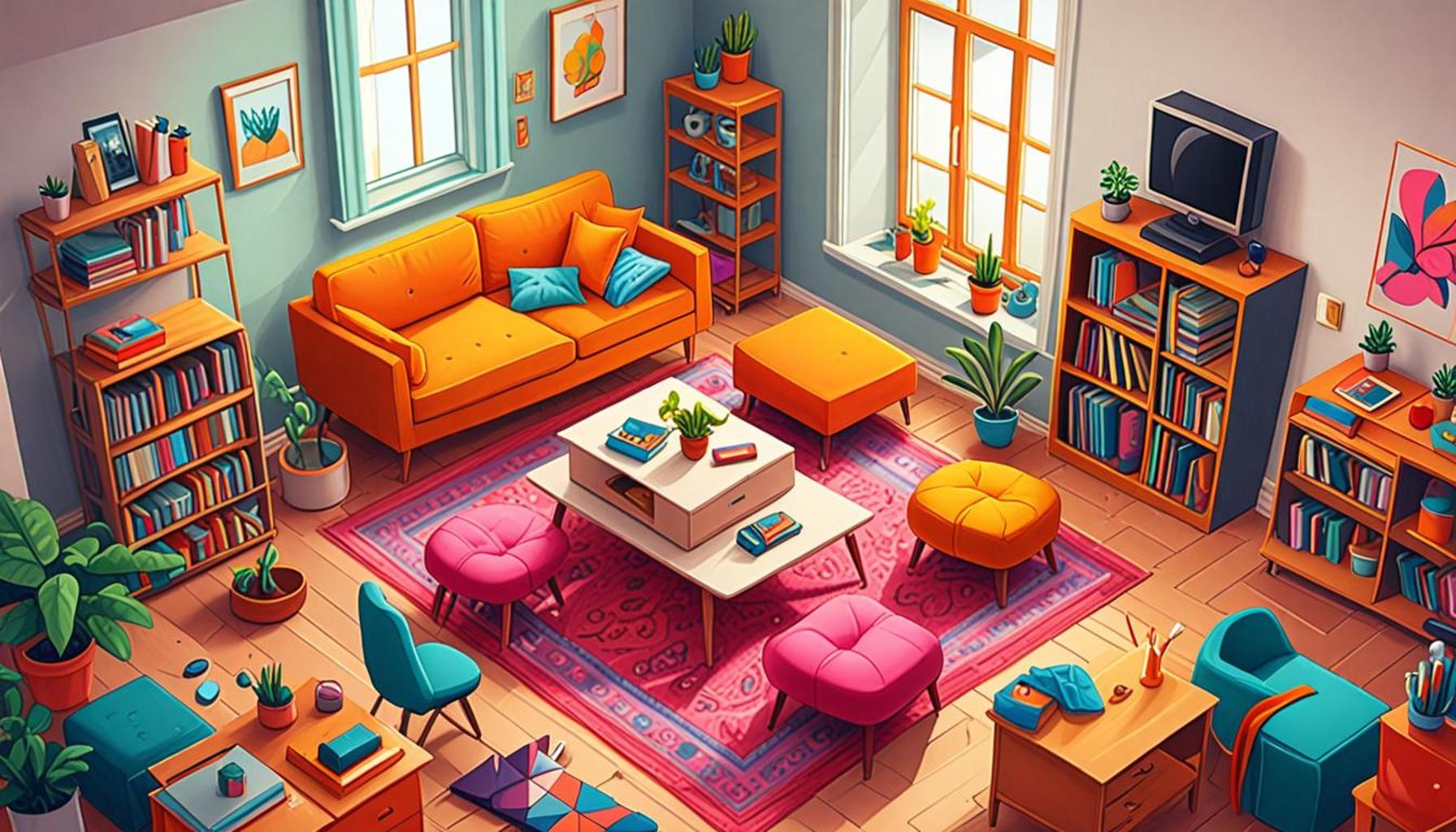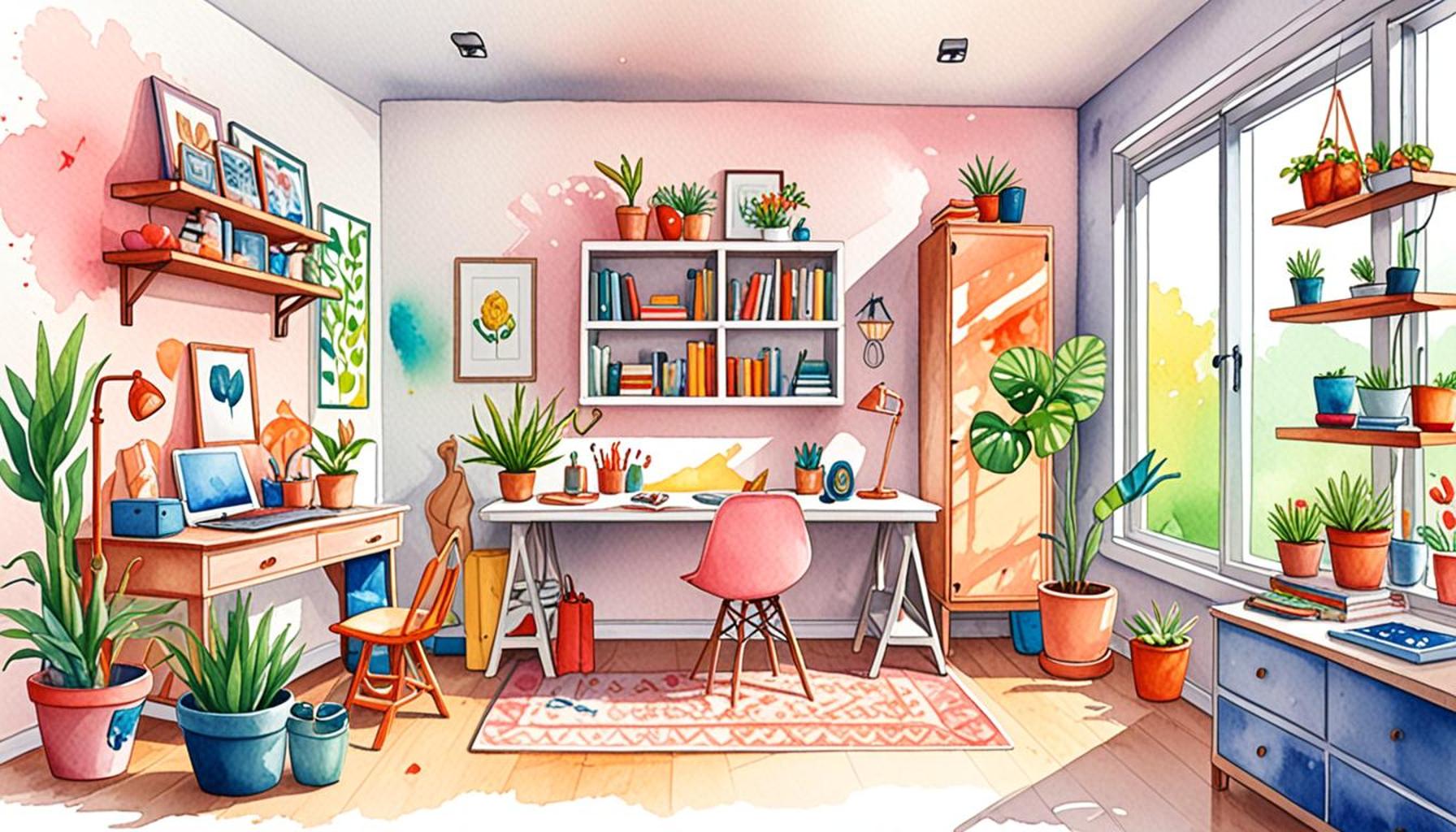How to Rearrange Furniture to Maximize Small Spaces Effectively

Making the Most of Your Space
Living in small spaces can be both a challenge and an opportunity. With the right furniture arrangement, you can transform a cramped area into a stylish and functional haven. Discovering effective methods to maximize every square foot is essential for comfort and style.
Key Principles of Furniture Arrangement
When it comes to rearranging your furniture, several guiding principles can make all the difference. These strategies can help you optimize your layout and create a space that feels open and inviting:
- Functionality: It’s important to prioritize the primary activities you perform in the space. For instance, if your studio apartment serves as both a living room and a workspace, consider a desk that can double as a dining table. This ensures that the area remains versatile and serves various purposes.
- Flow: Ensure that pathways are unobstructed for easy movement. A common mistake is to push furniture too close together, creating obstacles. Aim for a layout that allows for clear walking paths, which often involves placing larger furniture against walls to open up central areas.
- Visual balance: Distributing the weight of your furniture evenly across the room creates a sense of harmony. For example, if you have a sizable couch on one side, balance it out with a tall bookshelf or a piece of art on the opposite wall to draw the eye and prevent one area from feeling heavier than another.
Factors to Consider
Each space comes with unique features that can significantly impact your arrangement choices. To effectively maximize small spaces, keep these considerations in mind:
- Natural Light: Position furniture to allow light to fill the room. A well-lit space feels larger and more inviting. Avoid heavy drapery that blocks sunlight; instead, opt for light-colored curtains or blinds that can be easily opened.
- Multifunctional pieces: Embrace the trend of using items that serve more than one purpose. For instance, ottomans with storage, sofa beds, or foldable tables can enhance your space’s efficiency and accommodate guests when needed.
- Scale: Choose furniture that fits well, avoiding oversized pieces. A large sectional may dwarf a tiny living room, making it feel more cramped. Instead, go for streamlined designs that provide comfort without overwhelming the area.
As you delve into the art of effective furniture rearrangement, you’ll uncover endless possibilities. Each adjustment could unlock more space or improve the ambiance of your home. Whether you’re a college student in a cozy dorm room or a family in a compact house, these principles can help create an environment that suits your lifestyle. Ready to transform your small space into a masterpiece? Let’s explore the essential techniques to achieve that perfect fit and enhance your everyday living experience!
SEE ALSO: Click here to read another article
Discovering Your Space’s Potential
Maximizing small spaces involves careful consideration of your furniture layout. By understanding how to use your space efficiently, you can create an atmosphere that is not only functional but also aesthetically pleasing. When rearranging furniture, prioritize the unique potential of your space while exploring design options that can truly make a difference.
Creative Layout Techniques
To effectively rearrange furniture in small spaces, employ these creative layout techniques that transform cramped areas into cozy, inviting environments:
- Zone Creation: Define areas within your small space by using rugs, furniture, or even lighting. Zone creation allows you to designate a specific area for relaxation, work, or dining. For example, a small rug under a coffee table can create a living area, while a desk tucked in a corner serves as a defined workspace.
- Angled Furniture Arrangement: Placing furniture at angles, rather than straight against the walls, can open up a space and add interest to your layout. This technique creates depth and dimension, making the room feel larger and more inviting. For instance, angling a sofa toward the center of the room can foster conversation and draw guests in.
- Vertical Utilization: Don’t forget to look up! Using vertical space can maximize the potential of your small area. Tall bookshelves, wall-mounted shelves, or hangings for plants and art can draw the eye upward, creating an illusion of height. This can help in reducing clutter on surfaces and open up floor space.
Embrace Minimalism
Another key element in rearranging furniture effectively is embracing a minimalist aesthetic. When dealing with small spaces, less can often mean more:
- Streamlined Selections: Opt for furniture with clean lines and a simple silhouette. Avoid bulky designs that can overwhelm the space. Stick to essential pieces that serve a purpose, and consider items that are visually lightweight, providing comfort without compromising style.
- Declutter Regularly: Before rearranging, take the opportunity to declutter. Removing unnecessary items can provide clarity and breathing room in your space. Focus on keeping only what you need and love, allowing your furniture arrangement to shine without distraction.
- Consistency in Color: Choosing a cohesive color palette helps to create a flow throughout the room. Lighter colors can reflect light and make the space feel larger. Consider using a monochromatic scheme or soft pastels for a unified look that doesn’t overwhelm the senses.
By applying these creative layout techniques and embracing a minimalist ethos, you’ll not only maximize your small spaces but also create an overall sense of serenity and functionality. The key lies in experimentation—don’t be afraid to try different configurations to find the perfect fit for your lifestyle. Ready to dive deeper into specific arrangement styles? The adventure of reinventing your space awaits!
| Category | Description |
|---|---|
| Open Floor Plan | Utilizing an open layout helps create a sense of space, making areas feel larger and more inviting. |
| Multi-functional Furniture | Incorporating duel-purpose pieces like sofa beds and storage ottomans saves space while offering practicality. |
| Vertical Space Use | Maximizing vertical storage with shelving or tall cabinets frees floor space, enhancing the room’s utility and openness. |
| Decluttering Techniques | Regularly removing unnecessary items ensures the space stays functional and allows for a more organized appearance. |
In small spaces, rethinking furniture layout can greatly enhance functionality and aesthetic appeal. Embrace the open floor plan concept to avoid a cramped feeling. Use multi-functional furniture like extendable tables or convertible sofas, which not only provides practical solutions but also contributes to a more fluid environment. Additionally, focus on using vertical space for storage; shelves and cabinets that reach the ceiling can draw the eye upward, making a room feel more expansive. Finally, practicing decluttering techniques will keep the space organized and promote a sense of tranquility. Little adjustments can lead to a much more inviting and usable small space.
SEE ALSO: Click here to read another article
Smart Storage Solutions
When it comes to maximizing small spaces, smart storage solutions are essential. Finding innovative ways to incorporate storage can free up floor space while maintaining an organized environment. Here are some practical ideas:
- Multi-Functional Furniture: Incorporate furniture that serves multiple purposes. A coffee table with built-in storage can cleverly hide magazines or blankets, while an ottoman that doubles as seating and offers storage can be a game changer. Look for beds with drawers or lofted designs that allow for room beneath for additional storage solutions.
- Under-Utilized Spaces: Consider areas in your home that may not seem useful at first glance. Under beds, stairs, or even over doors can be transformed into clever storage spots. Floating shelves can maximize wall space in a stylish way, while hooks or pegboards mounted near entryways keep items like keys or bags handy without taking up valuable horizontal space.
- Organizational Tools: Utilize baskets, bins, and trays to keep smaller items organized. Labels can also improve accessibility and make finding what you need a breeze. Think of vertical organizers in closets or on countertops, and always choose options that stack or fit snugly together to maximize efficiency.
Create Illusions of Size
In small spaces, the perception of size can be enhanced through visual tricks. Leveraging design strategies can significantly affect how spacious a room feels!
- Mirrors: Incorporating mirrors can instantly transform a space by reflecting light and creating depth. A large mirror against one wall can make a narrow hallway seem wider or amplify natural light from windows. Position mirrors strategically to maximize their effect.
- Clear Furniture: Consider transparent furniture, such as acrylic chairs or glass tables, which can blend seamlessly into the background. This helps maintain an open feel as they take up less visual space while still serving essential functions in your layout.
- Open Shelving: Rather than bulky, closed cabinets, opt for open shelving that allows you to display decorative items and keep essentials accessible. This style not only adds character but also reduces the feeling of clutter, contributing to an overall airiness.
Personal Touches and Functionality
Finally, enriching small spaces with personal touches can enhance comfort while ensuring the area remains functional. Here are some personalized strategies:
- Artistic Displays: Incorporate artwork or personal photos to evoke a feeling of home. Thoughtfully arranged art can become both a focal point and a conversation starter. However, be cautious not to overcrowd walls, as negative space also plays a significant role in perception.
- Seasonal Changes: Refresh your setup periodically by swapping out decorative pieces or redefining your furniture arrangement. Seasonal changes can help keep every inch of your small space feeling fresh and personalized.
- Customize Your Space: Ultimately, every space is unique. Evaluate your specific needs and lifestyle to make choices that benefit your daily routine. Think about how you wish to use the space and let that guide your decisions, enabling you to establish a layout that functions as well as it looks.
Utilizing smart storage, creating size illusions, and adding personal touches to your furniture arrangement can truly enhance small spaces. By experimenting with different strategies, you can create a harmonious living environment that feels open, organized, and uniquely yours.
SEE ALSO: Click here to read another article
Conclusion
Maximizing small spaces is an art that combines innovative furniture arrangement, strategic use of smart storage solutions, and the incorporation of personal touches. By embracing the principles outlined in this guide, you can elevate any compact area into a functional and inviting sanctuary. Remember, the key to successful furniture rearrangement lies not just in the aesthetics but in creating an environment that suits your lifestyle and needs.
Your space should not only feel larger but also serve you effectively. Utilize multi-functional furniture to save space while enhancing utility. Be creative with under-utilized areas to create hidden storage that reduces clutter and keeps essentials at hand. Additionally, consider using mirrors and clear furniture to create visual expansiveness, making your home feel more open and airy.
Lastly, infusing your personality into your design choices ensures your space is truly a reflection of you. Whether it’s through art displays or seasonal updates, staying engaged with your environment enhances your comfort and connection to your home. By thoughtfully applying these strategies, you will discover that small spaces can be stylish, practical, and effortlessly enjoyable. As you continue to explore and experiment, you’re sure to find the perfect balance that transforms your small area into a harmonious living space.


